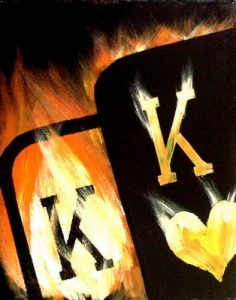
Refined to its essence, game flow is a language. The words of this language are the structures of folds and bets through which two players communicate. As in any language, they do not communicate directly – phrases have only the meaning assigned to them. In this way, players note and imitate patterns of randomness.
Let's recall the point grids. When thinking about randomness, people tend to create unusually orderly structures, and poker players are no exception. Moreover, when players encounter randomness, it is an experience. Even if they intellectually understand all the subtleties of created randomness, in poker, they will not receive a specifically analyzed string of letters, so they may not notice everything.
Now we know how our opponent imagines randomness – orderly and uniform. In this case, it doesn't really matter what the actual randomness is, that it clusters into groups and is irregular. Our goal is not to truly do everything randomly but to make the opponent think that everything is happening randomly. This means that our actions must match his preconceived ideas about randomness.
When creating our game flow lines, we should consider that they are regular, and we should distribute actions so that they are as even and orderly as possible (with enough variation, making sure it is not just a repeated “three folds, one bet” pattern). We want to imitate a clear, periodic, pseudo-random game flow.
Everything would be quite simple if we stopped here. But this is where the confusion of game flow begins.
The way to write randomness (which we discussed in previous articles) is the first stage of the game of imitated randomness. This is because everyone tries to arrange their game in this way; it is the norm. The opponent will automatically conclude that you are doing the same. If you do it very well, he will simply think that you understand how it should be done. These are the basic rules of this language.
So, to improve, we need to rise from this level to a higher one and engage in “wordplay.”
Remember that your value bets, marked V, which are truly random, will sometimes inevitably cluster after B (bets). It just happens sometimes. The first-stage randomness imitator will almost always try to cool down the situation after such a series, as if saying to the opponent: “My image is not like that! It's just a series of good hands, I'm not to blame!”
The second-stage player plays using language. He knows that his opponent has been  conditioned by other poker players and has seen series of good hands as accidental. In this way, these clustered groups are considered harmless. And because he understands this, the second-level player can use such clusters as a weapon in his game flow arsenal.
conditioned by other poker players and has seen series of good hands as accidental. In this way, these clustered groups are considered harmless. And because he understands this, the second-level player can use such clusters as a weapon in his game flow arsenal.
Instead of always trying to fake spacious lines, he simply uses clusters, thus creating second-degree game flow phrases. For example, if we describe phrase 1 with the line B.F.F.F, as a simple spacious randomness phrase, and phrase 2 – B.B.F.B, the second-degree game flow would look like this:
1 · 1 · 2 · 1 · 1 · 2 · 1 · 2 · 1 · 1
What is the player doing here? He is applying the same spaciousness but at a higher level, simply taking advantage of the first-level innocent hand clusters, he can increase the number of bluffs.
To achieve mastery in game flow, a player must learn very well how to play with clustered hands. The best players know the mutual possibilities of playing with such clustered lines, so their game already becomes a battlefield for their minds.
Finally, you have to experiment and play a lot to see how your opponent reacts to hand clusters, how much he believes in them, and where his limit is when he starts taking counteractions. Ideally, you should balance on that edge without crossing it.





